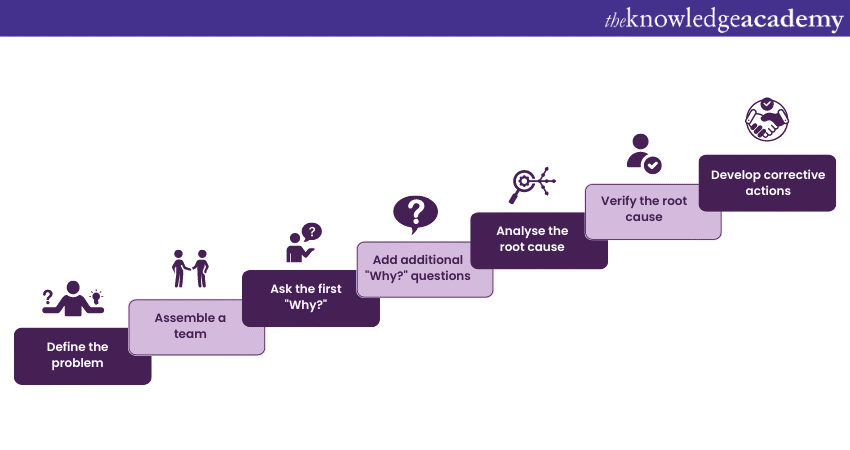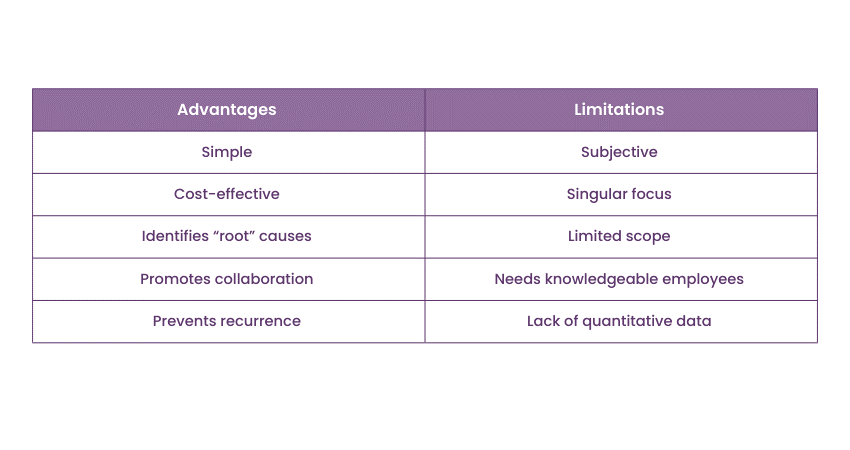We may not have the course you’re looking for. If you enquire or give us a call on +971 8000311193 and speak to our training experts, we may still be able to help with your training requirements.
Training Outcomes Within Your Budget!
We ensure quality, budget-alignment, and timely delivery by our expert instructors.

The 5 Whys strategy involves asking “Why?” multiple times to strip away the superficial layers of symptoms and apparent causes, leading to a profound comprehension of the primary problem
Are you eager to delve deeper into the 5 Whys technique within Root Cause Analysis Tools to foster ongoing improvement? This blog will help you grasp the essence of the 5 Whys in Root Cause Analysis. You will discover how to apply it effectively and understand its advantages and potential drawbacks.
Table of Contents
1) 5 Whys Root-Cause Analysis – An introduction
2) When to use a 5 Whys Analysis?
3) How to conduct the 5 Whys Root Cause Analysis?
4) What is a 5 Whys Template?
5) Advantages and limitations of the 5 Whys methodology
6) 5 Why Examples
7) Tips for using 5 Whys in Root Cause technique
8) Conclusion
5 Whys Root-Cause Analysis – An introduction
The “5 Whys” technique is a robust tool for problem-solving in Root Cause Analysis (RCA). It seeks to identify the root cause of a problem by asking a sequence of “Why?” questions.
Originating from the manufacturing sector, this method has gained widespread acceptance in various fields for its simplicity and efficacy. It operates on the principle that problems are typically not standalone occurrences but are linked to related factors.
This method works on a simple rule: pose the question “Why?” repeatedly for any given issue. This process enables organisations to drill down to the factors that contribute to the problem’s existence. Additionally, the 5 Whys approach assists in retracing the sequence of events to pinpoint the core cause.
Employing the 5 Whys allows individuals and organisations to gain a deeper insight into intricate issues, paving the way for more precise interventions.
However, it’s crucial to recognise that the 5 Whys doesn’t always lead to a single, clear-cut answer. Complex problems may stem from various root causes, and this iterative inquiry can reveal many contributing elements.
To overcome these constraints, integrating the 5 Whys with other analytical methods like Fishbone Diagrams, Process Flowcharts, or Data Analysis is often beneficial, enhancing the overall problem-solving strategy.

When to use a 5 Whys Analysis?
5 Whys is a tool for finding the root cause of a problem by asking “why” five times. It works best for simple or moderate problems, not complex or critical ones. To solve complex problems, you may need other methods like Cause-and-Effect Analysis or Failure Mode and Effects Analysis.
Use 5 Whys when something goes wrong with a system or process. It can help you fix the problem quickly and effectively. Don’t start with a solution in mind but follow the logic of the questions.
5 Whys is simple but flexible. It is often used in Lean Manufacturing to reduce waste and improve quality. It is also part of the Six Sigma approach to problem solving.
How to conduct the 5 Whys Root Cause Analysis?
The 5 Whys in Root Cause Analysis follow a structured approach. Organisations can effectively apply this structured technique and gain valuable insights into the Root Cause of an issue. Here is a step-by-step guide to help you navigate the process:

Step 1: Define the problem
Begin by pinpointing the exact problem that requires analysis. Clarify the issue to ensure that your analysis is targeted and effective. This initial step is crucial as it lays the groundwork for the entire investigative process, steering all subsequent actions towards discovering the root cause.
Step 2: Assemble a team
Form a team with a direct connection to or knowledge of the issue. Incorporating a variety of viewpoints can enhance the analysis, leading to a more thorough understanding. Moreover, a team approach ensures a multifaceted examination of the problem.
Step 3: Ask the first "Why?"
Kick off the inquiry by posing the initial question: “Why did this problem arise?” Aim to concentrate on the direct cause of the issue. Encourage all team members to engage in brainstorming and contribute their perspectives. The objective here is to unearth the most evident cause of the problem.
Step 4: Dig deeper with additional "Why?" questions
Following each response from Step 3, continue the inquiry by asking “Why?” again, connecting each query to the preceding response. Continue this line of questioning to peel back the layers of causation.
While aiming to reach a minimum of five levels of questioning, the actual number may fluctuate based on the problem’s intricacy. This iterative questioning process is designed to reveal underlying causes, moving past immediate and apparent factors.
Step 5: Analyse the root cause
After progressing through the iterative “Why?” questions, scrutinise the final response you’ve arrived at following the fifth inquiry. This response indicates the fundamental cause—the primary factor whose resolution can avert the recurrence of the issue. Delve into an in-depth analysis of this fundamental cause, assessing its influence on the problem and identifying recurring patterns, linkages, or systemic issues.
Step 6: Verify the root cause
To validate the accuracy of the identified fundamental cause, corroborate it with empirical data, firsthand observations, or other pertinent evidence. This step is essential as it offers authenticity and assurance to your analysis. Cross-checking the fundamental cause against trustworthy sources is crucial for substantiating its legitimacy.
Step 7: Develop corrective actions
Utilising the insights derived from your analysis, engage in brainstorming to formulate suitable corrective measures. These measures should be designed to confront the fundamental cause directly. They should aim to eradicate or diminish its effects.
Focus on devising practical and achievable interventions that can effectively address the fundamental cause and forestall similar issues in the future. Adhering to this structured guide will help you adeptly implement the 5 Whys technique in Root Cause Analysis. It’s important to include key stakeholders in the process, foster transparent and candid dialogue, and embrace a philosophy of ongoing enhancement.
Enhance your expertise in IT Service Management with our comprehensive ITIL® Certification Training.
What is a 5 Whys Template?
The 5 Whys Template is a foundational tool in Root Cause Analysis and problem-solving endeavours. An iterative questioning approach facilitates the exploration of cause-and-effect relationships underlying specific issues. Beginning with a problem statement, teams engage in a series of "why" inquiries, typically repeated five times, to uncover the Root Cause systematically. The following are some of the commonly used templates for resolving issues easily:
Single Lane Template
The Single Lane Template, within the 5 Whys framework, represents a streamlined approach where a single team or individual conducts the root cause analysis. This template guides users through a linear progression of questions, maintaining a focused trajectory toward identifying the root cause of a singular issue. Analogous to a single-lane road, it ensures traffic flows in a single direction without the complexity of multiple lanes or pathways.
Multiple Lane Template
The Multiple Lane Template introduces complexity, often depicted through a swimlane diagram. The process is segmented into multiple lanes, representing distinct departments, teams, or organisational facets.
This structure enables a comprehensive analysis of multifaceted problems involving various stakeholders. Swimlane diagrams aid in visualising and organising tasks, responsibilities, and workflows across different entities. They help facilitate the identification of inefficiencies and areas for enhancement.
Learn about the ITIL® 4 Service Management framework with our ITIL® 4 Foundation Certification Course.
Advantages and limitations of the 5 Whys methodology
The 5 Whys in Root Cause Analysis technique offers several advantages in uncovering the underlying problem. However, like any tool, it also has its limitations. Therefore, understanding its advantages and limitations is crucial for practical application. Delve into the advantages and disadvantages of Root Cause Analysis for insights. Let’s explore them:

Advantages of 5 Whys methodology
The following are the advantages of using 5 Whys method in RCA:
a) Simplicity: The 5 Whys approach is straightforward and user-friendly. It eschews the need for intricate tools or in-depth training, making it accessible to team members at every level within an organisation.
b) Cost-effective: This method is economical as it doesn’t necessitate a substantial financial outlay. It depends mainly on the collective skills and insights of the analysis team.
c) Identifies Root Causes: Through persistent inquiry into the “Why?” behind a problem, this method digs into the causal chain to pinpoint the root cause, moving past the apparent symptoms to the core issues.
d) Promotes collaboration: The iterative questioning process fosters a collaborative environment where team members can offer diverse viewpoints and expertise, leading to a more thorough analysis.
e) Prevents recurrence: By focusing on and resolving the root cause, the 5 Whys method in RCA formulates specific corrective actions designed to avert future recurrences, thereby improving solution efficacy and minimising the risk of similar problems arising again.
Limitations of 5 Whys methodology
The following are the limitations of using the 5 Whys method in RCA:
a) Subjectivity: The success of the 5 Whys method is highly dependent on the team’s capacity to pose appropriate questions and objectively interpret the responses. Subjective biases or preconceptions can skew the analysis, potentially leading to flawed or incomplete findings.
b) Singular focus: The 5 Whys approach concentrates on a solitary issue at a time, which may not be effective for multifaceted problems with numerous interconnected causes that demand a wider analytical approach.
c) Limited scope: This technique might not reveal every contributing factor to a problem, particularly when external factors outside the immediate analytical boundary are at play.
d) Dependence on knowledge and experience: The quality of the questions and the accuracy of the root cause identification are contingent upon the knowledge and experience of the participants. A deeper understanding of the subject matter can enhance the ability to pinpoint precise root causes.
e) Lack of quantitative data: The 5 Whys method predominantly utilises qualitative data and subjective evaluations. Without ample quantitative data to bolster the analysis, the conclusions’ precision and dependability may be compromised.
5 Whys example
Here's an example showing how 5 Whys in Root Cause Analysis works:
Problem Statement: The latest software updates newsletter wasn’t dispatched as scheduled.
5 Whys Analysis:
a) Why was the newsletter delayed? The software updates were not ready by the deadline.
b) Why weren’t the updates ready? The development team was still finalising new features.
c) Why were new features incomplete? A new developer was not familiar with the necessary procedures.
d) Why did the new developer lack knowledge of the procedures? They received inadequate training.
e) Why was the training insufficient? The Chief Technology Officer (CTO) believes that hands-on experience, rather than formal training, is more beneficial for new hires.
This analysis reveals the initial technical issue as a procedural problem, underscoring the importance of considering human factors in problem-solving. The 5 Whys technique delves deep into an issue to uncover its origin. Remember, the number “5” is not fixed; continue asking “Why” until you’ve thoroughly addressed the problem and can implement a viable solution. Explore Causal Analysis vs Root Cause Analysis for sharper problem-solving insights.
Tips for using the 5 Whys in Root Cause Analysis technique
Here are some tips for effectively using the 5 Whys technique:
a) Consistent questioning tempo: Keep a consistent rhythm in your questioning to fully grasp the issue before reaching any conclusions.
b) Flexibility in application: The number “5” in the 5 Whys is merely a benchmark. Depending on the complexity of the problem, it may be necessary to delve deeper with additional “Why?” questions to identify the Root Cause.
c) Judicious conclusion: Determine the appropriate moment to end the inquiry. Cease the “Why?” questions when you have collected enough relevant information, thus avoiding premature conclusions and ensuring a meticulous evaluation.
Enroll in ISO 55001 Foundation Training in the UK to enhance your asset management skills and boost career growth!
Conclusion
The 5 Whys in Root Cause Analysis is a powerful yet simple technique that promotes deep inquiry and collaborative problem-solving. While its limitations include potential subjectivity and a narrow focus, its simplicity and cost-effectiveness makes it a valuable first step in identifying and addressing the underlying causes of issues to prevent their recurrence.
Learn how to identify and manage Root Cause issues successfully with our Root Cause Analysis Training!
Frequently Asked Questions

Organisations can foster a culture of using the 5 Whys for continuous improvement by promoting open communication, providing training and resources, recognising and rewarding problem-solving efforts, and integrating the technique into standard operating procedures and performance evaluation processes.

The 5 Whys Analysis can be used in practice by identifying the root cause of problems, implementing effective solutions to prevent recurrence, improving processes and systems, enhancing decision-making, fostering a culture of continuous improvement, and driving organisational success.

The Knowledge Academy takes global learning to new heights, offering over 30,000 online courses across 490+ locations in 220 countries. This expansive reach ensures accessibility and convenience for learners worldwide.
Alongside our diverse Online Course Catalogue, encompassing 17 major categories, we go the extra mile by providing a plethora of free educational Online Resources like News updates, Blogs, videos, webinars, and interview questions. Tailoring learning experiences further, professionals can maximise value with customisable Course Bundles of TKA.

The Knowledge Academy’s Knowledge Pass, a prepaid voucher, adds another layer of flexibility, allowing course bookings over a 12-month period. Join us on a journey where education knows no bounds.

The Knowledge Academy offers various ITIL Certification Courses, including the ITIL 4 Foundation, Specialist and Strategist Courses. These courses cater to different skill levels, providing comprehensive insights into How to Perform Root Cause Analysis.
Our IT Service Management Blogs cover a range of topics related to Root Cause Analysis, offering valuable resources, best practices, and industry insights. Whether you are a beginner or looking to advance your Root Cause Analysis skills, The Knowledge Academy's diverse courses and informative blogs have got you covered.
Upcoming IT Service Management Resources Batches & Dates
Date
 Root Cause Analysis
Root Cause Analysis
Fri 7th Feb 2025
Fri 30th May 2025
Fri 29th Aug 2025
Fri 28th Nov 2025







 Top Rated Course
Top Rated Course


 If you wish to make any changes to your course, please
If you wish to make any changes to your course, please


